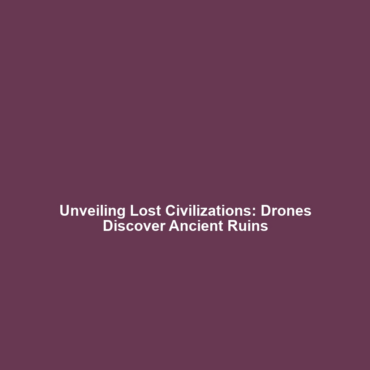Case Studies: Drones Uncovering Hidden Mayan Ruins and Roman Infrastructure in Europe
The advent of drone technology has revolutionized the field of archaeology, allowing researchers to uncover hidden Mayan ruins and Roman infrastructure throughout Europe. Utilizing advanced aerial imaging and data analysis, drones enable archaeologists to explore sites that traditional methods might overlook. This integration of modern technology into scientific investigation not only enhances our understanding of ancient civilizations, but also emphasizes the broader significance of Drones in Science.
Key Concepts
Drones equipped with high-resolution cameras and LiDAR (Light Detection and Ranging) systems provide an innovative approach to archaeological research, which fits neatly into the category of Drones in Science. Here are some major concepts related to how these drones function:
- Remote Sensing: The use of drones allows for the collection of large datasets over extensive areas without disturbing the ground.
- High-Resolution Imaging: Drones capture detailed images that reveal features of archaeological sites not visible from the ground.
- Data Analysis: Advanced software helps in analyzing the collected data, leading to discoveries about site layouts and construction techniques.
Applications and Real-World Uses
The applications of drones in uncovering hidden Mayan ruins and Roman infrastructure illustrate their transformative impact on archaeology under the broad umbrella of Drones in Science. Some notable examples include:
- Discovery of New Ruins: Drones have aided in the discovery of previously unknown Mayan sites in Central America, enhancing our understanding of the region’s history.
- Mapping Roman Roads: In Europe, drones have been used to map and analyze the remnants of Roman roads, revealing insights into ancient trade routes.
- Preservation Efforts: Drones facilitate documentation for the preservation of sites, ensuring that history is safeguarded for future generations.
Current Challenges
Despite the promising prospects of using drones for archaeological discoveries, several challenges remain. Key issues often encountered include:
- Regulatory Restrictions: Local laws regarding drone usage may limit exploration and data collection.
- Technological Limitations: Not all regions may have access to high-quality drone technology, hindering research capabilities.
- Data Interpretation: The vast amount of data collected can complicate analysis, requiring specialized skills and tools.
Future Research and Innovations
As technology evolves, so too do the capabilities of drones in uncovering historical sites. Looking ahead, innovations such as AI-driven data analysis, improved sensor technology, and enhanced battery life promise to enhance the effectiveness of drones in archaeological research. These breakthroughs are set to redefine Drones in Science and broaden the horizons of what can be discovered in the archaeological landscape.
Conclusion
The case studies of drones unveiling hidden Mayan ruins and Roman infrastructure demonstrate their crucial role within the realm of Drones in Science. By overcoming traditional barriers of archaeological exploration, drones are transforming the way we discover and understand our past. To stay informed about advancements in drone technology and their applications in archaeology, explore other related topics on our website.
